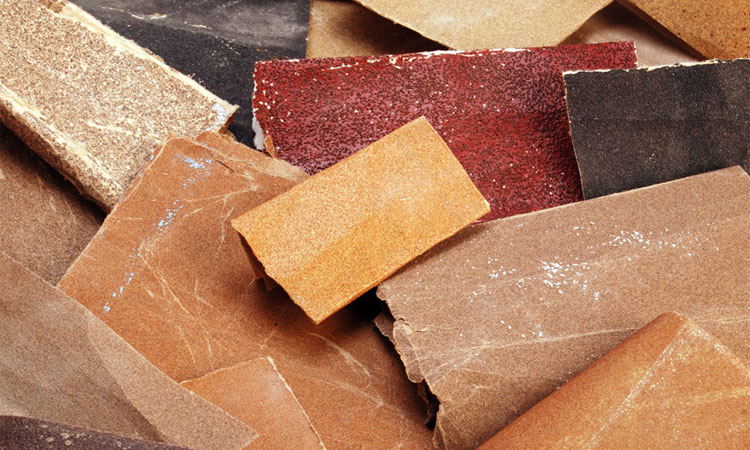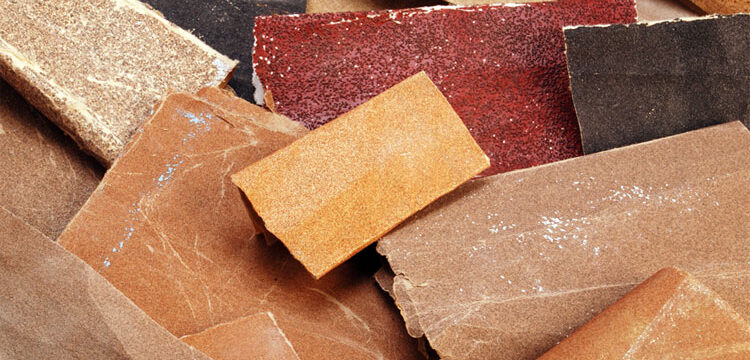Sandpaper has been in use for hundreds of years and is now a fundamental tool in most homes. You can easily buy sandpaper and sanding pads online, but they’ve come a long way. Have you ever wondered how it’s produced, though?
Sandpaper is made by placing abrasive minerals such as aluminium oxide, garnet, and silicon oxide on a paper backing and drying it under pressure. These materials provide sharp edges for the sandpaper to work as a cutting/smoothing tool.

This article will go over what sandpaper is composed of, the different minerals and garnets used, who invented it, and what else was utilised before.
What Is Sandpaper Made Of?
Sandpaper is formed by glueing abrasive materials, such as minerals and garnets, to a paper backing. The surface may be covered with an open coat or closed coat abrasives, depending on the type of sandpaper you purchase. Each has its own set of characteristics.
For sanding softer materials like aluminium, cedar, or brass, such as paper and plastic, sandpaper with open abrasive surfaces is preferable. It’s made up of densely packed grains. A closed abrasive surface, on the other hand, is superior for sanding hard materials like oak and steel. There are numerous distinct sorts of sandpaper available, some of which have additional properties such as backing, abrasives, and bonding agents. The grit size of the sandpaper is its size in square inches; you may determine the precise measurement required by matching it to the number of minerals per square inch.
How To Make Sandpaper at Home
It’s also possible to make sandpaper yourself for a fraction of the cost. Making your own sandpaper may be advantageous in certain instances. Follow these procedures to produce sandpaper at home:
- Begin with a rough, thick sort of paper.
- Apply a liquid adhesive to the surface.
- Sprinkle sand over the still-wet surface of the paper with a gardening wire sifter.
- Allow the glue to sit until it has hardened.
- Attach a wooden board to the wall, then secure the paper with clamps.
- Allow to rest for 1-2 days before serving.
What Mineral Is in Sandpaper?
Aluminum Oxide
The most frequent mineral is aluminium oxide, which has a stronger structure and longer lifespan than other minerals. Aluminium oxide is also the preferred abrasive for power-grade sanders. This heavy-duty abrasive is ideal for metalworking.
Alumina-Zirconia
Sandpaper is composed of a variety of minerals, including feldspars, quartz, mica, calcium carbonate (limestone), silica (sand), and alumina-zirconia (ceramic). The greater the cost, the more often this mineral is used in conjunction with other abrasives.
Silicon Carbide
Sandpaper made of this mineral might also contain silicon carbide. Only one grade of sandpaper is produced from this mineral, and it’s renowned for sanding wet or dry surfaces. One disadvantage with this is that the sandpaper will generally wear down faster.
Alumina and Diamond
Finally, minerals containing zirconium alumina or alumina are regarded as strong and are most often utilized in foundries. At the same time, other minerals such as diamond or cubic boron nitride are more difficult and are generally used for more specialized polishing procedures.
Who Invented Sandpaper?
Sandpaper has been used for millennia. The Egyptians utilized sandstone (which is a naturally bonded abrasive) to construct their pyramids.
Sandpaper was first used in China during the thirteenth century, according to historical records. The Chinese utilized crushed seashells, sand, or seeds, as well as natural “gums,” to adhere the substance to parchment. After years of trial and error, new coated abrasives were invented.
